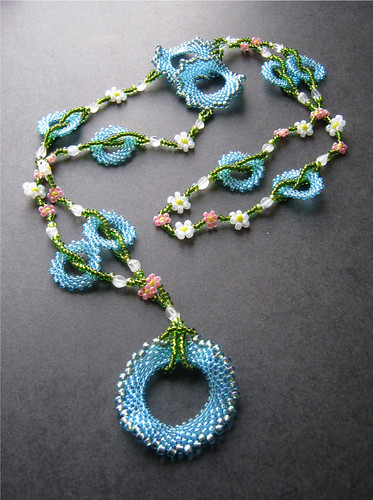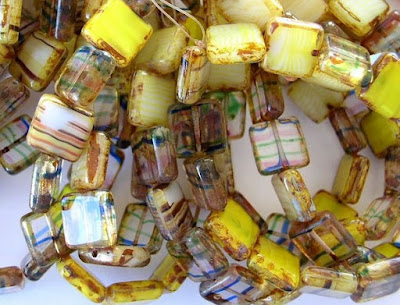We’re going to continue our examination of beading ethics today, with a look at online tutorials, projects and designs. But before we begin, we should address some of the excellent questions that came up in
Part One.
First, it’s important to note that any discussion on ethics is purely theoretical, and there is a distinct difference between ethics and pattern copyright, or intellectual copyright. The rules of ethics vary between regions and groups, but the basic purpose is the same - to guide us.
Ethics help us to know what we should do, not what we can or can’t do (legally or otherwise). If you are faced with a design or inspiration dilemma that has no definite answer, it comes down to what action you are comfortable with, in the present and in the future.
Next, what is the difference between technique and design? Peyote stitch, herringbone weave, wrapped loops, macramé knots - we know these are all examples of techniques. It is the combinations and applications of techniques in a finished piece that make a design unique. A technique can be used very simply, but in a variety of ways, or made complex and elaborate.
For instance, herringbone weave is a common way to make a cuff bracelet. There are hundreds of different ways to combine bead shapes, sizes, and colors with this simple technique. The more complex the application, the more unique the design.

Herringbone Highway Cuff by Aryd’ell Hotelling

Spur of the Moment Bracelet by Beth Stone
Sometimes, even the simplest techniques can produce a very original design. You’re probably familiar with the trendy floral necklace characterized by a strand big colorful beads connected by simple loops, and an asymmetrical focal. It’s an easy design to dissect and recreate, which is why there are hundreds of them all over the internet. But, this design (probably) came from a single person - a single designer with a great idea, who now has to compete with all of the inspired copies, many of which are nearly identical in execution and style.

Another example is the Scrabble tile pendant. Someone had to formulate, test and execute that simple but ingenious idea. It’s not clear whether or not he or she intended the technique to be free and fair game for jewelry sellers. Perhaps the creator is happy to have inspired so many crafters, but it is just as likely that they really regret not getting a patent for their idea. (Here again, we put a toe into the realm of copyrights and patents, but just for the sake of argument. There are hundreds of tutorials available for Scrabble tile pendants, which may or may not indicate that it was originally offered as a 'public domain' kind of technique.)
Part Two: Online Tutorials and Projects
Can I use techniques in my work that I’ve learned online*?
Of course! Just like in magazines and beading books, online tutorials for basic techniques are usually shared to help artists learn. Basic methods such as peyote stitch, decoupage, and crochet are available to everyone - to use and to share. There can be exceptions of course, if a designer has developed a never-before-seen technique that is very unique. One example is
Keplar’s Star Weave by Gwen Fisher. In these cases, however, it is unlikely that the designer will share a free, public tutorial for the technique.
* In this discussion, we’re talking about publicly published tutorials, such as those found on blogs, craft websites, and forums.

What about complete projects?
There are many bloggers, bead shops, and webmasters that share complete tutorials for making finished projects online, for free. There are a variety of reasons for publishing these projects, including selling the materials, encouraging beaders to try new techniques, and even increasing one’s readership and SEO. Because they are free and public, anyone can follow the instructions and make the designs.
However, unless the designer or instructor indicates that the project is available for commercial use* it is meant only for learning and enjoyment. Some bloggers will indicate in the tutorial, or elsewhere on the site, that projects are for personal use only. Many don’t, for some of the same reasons that book and magazine publishers don’t include prominent disclaimers - it’s just common sense. These kinds of tutorials are intended for hobbyists, not professional crafters.
* Typically, commercial use means to sell finished pieces, offer the project for commission work, donate finished pieces, or display them for promotional purposes. Mass-producing the project is a different matter, and is almost never allowed by any designer.
What if my project is different from the original?
This is always the place where we can become unsure. If you presented two variations of the same project to a jury, each person would have a different opinion on how different they are. One of the best ways to examine how original a recreation or inspiration is, is to compare the projects side by side. Would a beading novice recognize a connection between the designs? Are any additional techniques, stitches, turns or components incorporated into the new piece? Would the original designer recognize their ideas upon seeing it?
This question is also covered in the last discussion of
Design Ethics for Beaders. Many of the same questions and answers apply to books as well as online tutorials. They also cover beading patterns - like complex patterns for peyote stitch that create a distinct image.
How do you feel about online design ethics? Questions and comments about these topics are welcome!
Further Reading:
The Beadwork Ethics Quiz on Beading Daily
State of Confusion by Regretsy (Contains some profanity)
Give Credit Redux and,
Another Look at Giving Credit Where Credit is Due by Haute Ice Beadwork
Copyright 2012
Inspirational Beading and Friends
Subscribe to Inspirational Beading
Get inspired on
Facebook























































